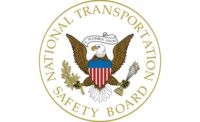 The Department of Transportation’s Federal Aviation Administration (FAA), airlines and aviation labor unions have announced a partnership with the National Transportation Safety Board (NTSB) to share summarized safety information that could help prevent accidents.
The Department of Transportation’s Federal Aviation Administration (FAA), airlines and aviation labor unions have announced a partnership with the National Transportation Safety Board (NTSB) to share summarized safety information that could help prevent accidents.
The information, shared through an initiative called the Aviation Safety Information Analysis and Sharing (ASIAS) Executive Board, will help the NTSB determine if an accident is a unique event or an indication of systemic risks. Under ASIAS, airlines and unions already voluntarily share safety information with FAA to identify trends.
“The nation’s impressive safety record is in part due to an unwavering commitment by government and industry to work together to monitor data and identify trends to prevent accidents,” said FAA Acting Administrator Michael Huerta. “More than 90 percent of air carriers use voluntary reporting programs and this has led to significant training, operational and maintenance program improvements.”
"The U.S. aviation industry's commitment to sharing safety information has already successfully helped us lower the fatality risk on commercial flights," said Captain Paul Morell, Vice President, Safety, Security and Environmental Programs, US Airways and ASIAS Executive Board co-chair. "Through ASIAS, we know that industry and government are investing in the right safety solutions."
ASIAS uses aggregate, protected data from industry and government voluntary reporting programs, without identifying the source of the data, to proactively find safety issues, identify safety enhancements, and measure the effectiveness of solutions. ASIAS began in 2007 and now has 44 members and receives voluntary data representing 95 percent of all commercial air carrier operations. It onnects 131 data and information sources across the industry and is integrated into the Commercial Aviation Safety Team (CAST) process. CAST is a joint government and industry effort that uses a data-driven strategy to reduce the commercial aviation fatality risk in the United States and promote safety initiatives throughout the world. Their work, along with new aircraft, regulations and other activities, reduced the fatality risk for commercial aviation in the United States by 83 percent from 1998 to 2008.
Seven of CAST’s 76 safety enhancements have been derived from forward-looking data analysis in ASIAS. Additionally, ASIAS stays connected to CAST’s safety enhancements to track the effectiveness of those interventions. The databases used to identify trends include Flight Operations Quality Assurance (FOQA) programs, the Aviation Safety Action Partnership (ASAP), the Air Traffic Safety Action Program (ATSAP), FAA surveillance data, and many others.
The agreement outlines the procedures, guidelines, and roles and responsibilities for the ASIAS Executive Board to address specific written NTSB requests for ASIAS information. The agreement does not allow any of the parties to use aggregate FOQA, ASAP, ATSAP or other non-publicly available data to measure an individual data contributor’s performance or safety.
The NTSB will initiate written requests for ASIAS information related to aircraft accidents involving U.S. air carriers that occur in the United States and address safety issues that both the NTSB and the ASIAS board determine are significant and non-routine or reoccurring. The NTSB will not publicly disclose ASIAS information it receives via the process unless the ASIAS Executive Board agrees.
The NTSB will share with ASIAS its archived air carrier accident and incident flight data recorder information related to a request.
Aviation industry, FAA and NTSB form accident-prevention partnership
Looking for a reprint of this article?
From high-res PDFs to custom plaques, order your copy today!





.jpg?t=1721257160)
